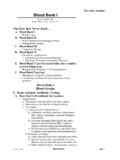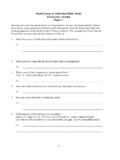Transcription of Monitoring the Cleaning Process for Flexible Endoscopes
1 Monitoring the Cleaning Process for Flexible Endoscopes The device from hell, the Flexible endoscope as described by Martin Favero, PhD, Director of Scientific and Clinical Affairs for Advanced Sterilization Products when refering to Cleaning and disinfecting this piece of medical A scope can be used anywhere from 300 to 1,200 times a year. The question is, can we be guaranteed that the scope has been processed appropriately each of those times? 2. Based upon the AAMI standards that are in place today, the scale of measurement here after instruments are washed is visual inspection. I think most of us would agree that a method of visually inspecting the instruments is not a very good method. 3. Newspaper headlines echo these thoughts: Company blames bronchoscope infections on poor Cleaning . 4. Clear concerns amid murky debate--Patient documents raise questions in dispute on endoscope infection risk.
2 5. Headlines like these were the needle on the compass that guided us to write a paper on the Cleaning of Flexible Endoscopes . Did you realize that getting a clean, high level disinfected/sterilized Flexible scope ready for patient use is like fitting puzzle pieces together? If one piece is missing, it is not complete. Let us look at the different pieces of the puzzle that make up the Process of ensuring a clean, sterilized/high-level disinfected scope ready for patient use. Puzzle Piece # 1. Background Information Three types of Endoscopes are commonly used in hospitals: rigid, semi-rigid and Flexible . This article will focus on Flexible Endoscopes ( , colonoscopes, duodenoscopes, gastroscopes, sigmoidoscopes), because concerns about Cleaning these scopes appear more often in news headlines. 1. There are a variety of Flexible Endoscopes types with differing channel sizes and configurations.
3 Bronchoscopes Intubation Scopes Colonoscopes Heightened concern about proper Cleaning of Flexible scopes is also reflected in the professional literature. A Flexible endoscope may contain many internal channels, any of which can become contaminated. Suction Valve Air / Water Valve Biopsy Valve Insertion Tube Nozzle Water Bottle Tube Light Source Water-Jet LIGHT SOURCE. Connector Universal Cord Connector Air Air Pipe Pump Biopsy/Suction Channel Water Channel Suction Connector Air Channel Water-Jet Channel WATER. BOTTLE. Endoscopes are complex medical instruments having long and narrow working channels that are subjected to torque and angulation forces These forces require special materials and engineering Endoscopes have state of the art electronics, including fiber optics and imaging technology 2. It is estimated that in the alone 15 million Flexible endoscope procedures are performed annually.
4 Procedures are performed in a variety of settings, from a doctor's office to a hospital surgical suite. The methods employed to clean and disinfect these Flexible Endoscopes are also very diverse. A key concern, no matter where these procedures are done, is how clean these scopes are after reprocessing. Puzzle Piece #2: Guidelines and Standards Reviewing the most recent set of guidelines, literature, and products prepares an endoscopy facility to provide the best possible patient care. Published in 2003 the Multi-Society (use the formal name) position paper states: Healthcare facilities should develop protocols to ensure that users can readily identify whether an endoscope is contaminated or is ready for patient use . (Gastrointestinal Endoscopy, Volume 58 ; page 5). This document also details excellent general practices for any medical facility from start to finish of a Flexible scope procedure.
5 AAMI ST 79 notes that the efficacy of any high-level disinfection/sterilization Process , depends on a consistent system for lowering and limiting bio-burden before the high- level disinfection/sterilization stage. They also state: Staff qualifications, training, and continuing education are important: . Personnel should receive in-service training for all new instrumentation, devices, and equipment. All orientation, on-the-job, and in-service training should be documented . (Section ). Verification of the Cleaning Process is important: Sterile processing personnel are increasingly aware of the need to control and standardize the steps taken to ensure the sterility of devices for patient use. Because disinfection and sterilization cannot be assured unless the Cleaning Process is successful, professionals in the field ought to seek out whatever means are available and practical to verify this function.
6 A quality system would call for Monitoring and documenting decontamination processing parameters, whether the Process is accomplished by hand or mechanically . (Section ). Another AAMI document that calls for verification of the Process is TIR 12; 2004. Some highlights of this document are: Using scientifically valid methods, the manufacturer should show that the recommended Cleaning Process is effective in removing the simulated soil from all surfaces of the device that could come into contact with the patient or that are accessible to tissue, blood, body fluids, and other organic material. Testing should be adequate to ensure that the Process can be successfully duplicated in the hospital environment. If all surfaces of the device cannot be visually inspected (as in the case of some devices with lumens and some hinged instruments), manufacturers should provide users with rapid test methods that can be used as part of quality 3.
7 Assurance to ensure that the Cleaning Process has been effective. Such test methods may apply to automated Cleaning equipment or to a specific medical device. Efficacy of the Process : Device manufacturers must show that recommended disinfection procedures ensure that all device surfaces (including internal channels) that will either come in direct contact with the patient or physician or be soiled with blood, body fluids, and other organic material will be in contact with the disinfectant Testing should be adequate to ensure that the Process can be successfully duplicated in the hospital environment Many of the products used for Flexible endoscopy are regulated by the FDA. The manufacture must submit detailed information on Cleaning and sterilization. Because many Flexible scopes are processed by Automated Endoscope Reprocessors (AER) the manufacture must comply with strict FDA guidelines.
8 Some of them are: Simulated-use testing should evaluate the performance of the medical washer- disinfector under worst case conditions. FDA defines worst case conditions as testing at the minimum parameters for the Process variables in each Simulated-Use and In-Use Tests: d. Simulated-use Testing 2) Incorporate other factors into the test that impede Cleaning and germicide activity, , a representative inorganic and organic challenge added to the inoculum. Include an organic challenge representative of the type of worst case organic load to which the device is exposed during actual use, such as serum, blood, and secretions, and may remain associated with the device following JCAHO standard states that medical equipment is maintained, tested and inspected. This would apply to the AER type equipment used to Process Flexible scopes. The American Society of Testing and Material (ASTM), has outlined test methods of interest for scopes8: E1837-96(2002) Standard Test Method to Determine Efficacy of Disinfection Processes for Reusable Medical Devices (Simulated Use Test).
9 E1766-95(2002) Standard Test Method for Determination of Effectiveness of Sterilization Processes for Reusable Medical Devices E2314-03 Standard Test Method for Determination of Effectiveness of Cleaning Processes for Reusable Medical Instruments Using a Microbiologic Method (Simulated Use Test). D2775-Standard Guide for Blood Cleaning Efficiency of Detergents and Washer- Disinfectors F1518-00 Standard Practice for Cleaning and Disinfection of Flexible Fiberoptic and Video Endoscopes Used in the Examination of the Hollow Viscera Specific patent processes also apply to Flexible scope some are: 4. 6428746 Method for determining the efficacy of decontamination procedure9 was developed by Dr. Larry Muscarella is simple: raise public health standards, improve the standard of care, and reduce the risk of patient infection. 6447990 Artificial Test Soil - This technology was developed by Dr.
10 Michelle Alfa at the University of Manitoba involving using artificial test soil (ATS). for simulated-use testing and validation of Cleaning protocols of medical devices. The soil was developed to mimic worst case conditions for simulated-use testing. ( ). All of this information is used by the manufacture as they develop Flexible scope products and validated methods for reprocessing to be used by a medical facility. Puzzle Piece #3: Medical Publication Medical publications have highlighted all kinds of issues with unclean instruments, poor training of staff and just bad practices: 57% of centers that Process scopes were not in compliance with basic national 53% of biopsy ports valves exhibited some form of debris or potential contamination after Company blames bronchoscope infections on poor Cleaning . 12. Endoscopes have been implicated in the transmission of disease (specifically nosocomial infections) when appropriate Cleaning , disinfection or sterilization procedures were not employed.








